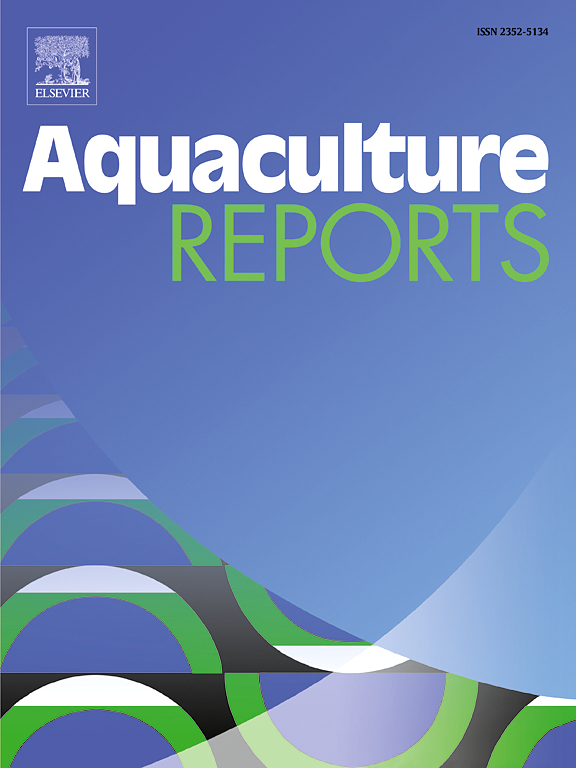LRP6 regulates growth in Litopenaeus vannamei via the Wnt/β-catenin signaling pathway
IF 3.2
2区 农林科学
Q1 FISHERIES
引用次数: 0
Abstract
Low-density lipoprotein receptor-related protein 6 (LRP6) is a crucial coreceptor in the canonical Wnt/β-catenin signaling pathway, that plays a fundamental role in cell growth, development, proliferation, and apoptosis. However, little is known about its effect on growth performance in economic animal including shrimp. In this study, we characterized a homolog of LRP6 in shrimp Litopenaeus vannamei, named LvLRP6, and explored its involvement in growth regulation. Multiple sequence alignments and phylogenetic analyses indicated that LvLRP6 belongs to the invertebrate LRP6 family and has conserved phosphorylation sites with those of LRP6 in other species. Functional investigations via RNAi technology revealed that silencing LvLRP6 via dsRNA injection resulted in a significant reduction in shrimp growth, as indicated by lower weight gain than that in the control group. Mechanistic exploration revealed that LvLRP6 positively modulates the Wnt/β-catenin pathway, leading to increased expression of core components such as glycogen synthase kinase 3 (LvGSK3), β-catenin (Lvβ-catenin), and T-cell factor (LvTcf). Furthermore, LvLRP6 exerted a suppressive effect on LvMSTN (myostatin), a negative regulator of muscle-related genes, while concomitantly increasing myosin levels. Subsequent research revealed that the promoter of LvMSTN contains TCF binding motifs. Dual-luciferase reporter experiments confirmed that the overexpression of LvLRP6 or LvTcf reduced the promoter activity of LvMSTN. Additionally, LvTcf was found to induce the expression of LvLRP6 and a number of Wnt ligands, thus amplifying Wnt/β-catenin pathway activation and reinforcing the growth-promoting feedback loop. The present investigation demonstrated the importance of LRP6 in shrimp growth, which contributes to our knowledge of the molecular processes that underlie crustacean growth and offers a theoretical basis for breeding and genetic enhancement initiatives aimed at enhancing shrimp aquaculture growth performance.
LRP6 通过 Wnt/β-catenin 信号通路调节万年青的生长
低密度脂蛋白受体相关蛋白6 (LRP6)是典型的Wnt/β-catenin信号通路中重要的辅助受体,在细胞生长、发育、增殖和凋亡中起着重要作用。但其对虾等经济动物生长性能的影响尚不清楚。在本研究中,我们在凡纳滨对虾(Litopenaeus vannamei)中鉴定了LRP6的同源物,命名为LvLRP6,并探讨了其在生长调节中的作用。多个序列比对和系统发育分析表明,LvLRP6属于无脊椎动物LRP6家族,与其他物种的LRP6具有保守的磷酸化位点。通过RNAi技术进行的功能研究显示,通过注射dsRNA沉默LvLRP6导致对虾生长显著降低,体重增加低于对照组。机制探索发现,LvLRP6正调控Wnt/β-catenin通路,导致糖原合成酶激酶3 (LvGSK3)、β-catenin (Lvβ-catenin)、t细胞因子(LvTcf)等核心成分表达增加。此外,LvLRP6对肌肉相关基因的负调节因子LvMSTN(肌肉生长抑制素)有抑制作用,同时增加肌球蛋白水平。随后的研究发现,LvMSTN的启动子含有TCF结合基序。双荧光素酶报告基因实验证实,过表达LvLRP6或LvTcf可降低LvMSTN的启动子活性。此外,我们还发现LvTcf可诱导LvLRP6和多个Wnt配体的表达,从而放大Wnt/β-catenin通路的激活,强化促生长反馈回路。本研究证明了LRP6在对虾生长中的重要性,这有助于我们了解甲壳类动物生长的分子过程,并为旨在提高对虾养殖生长性能的育种和遗传增强举措提供理论基础。
本文章由计算机程序翻译,如有差异,请以英文原文为准。
求助全文
约1分钟内获得全文
求助全文
来源期刊

Aquaculture Reports
Agricultural and Biological Sciences-Animal Science and Zoology
CiteScore
5.90
自引率
8.10%
发文量
469
审稿时长
77 days
期刊介绍:
Aquaculture Reports will publish original research papers and reviews documenting outstanding science with a regional context and focus, answering the need for high quality information on novel species, systems and regions in emerging areas of aquaculture research and development, such as integrated multi-trophic aquaculture, urban aquaculture, ornamental, unfed aquaculture, offshore aquaculture and others. Papers having industry research as priority and encompassing product development research or current industry practice are encouraged.
 求助内容:
求助内容: 应助结果提醒方式:
应助结果提醒方式:


